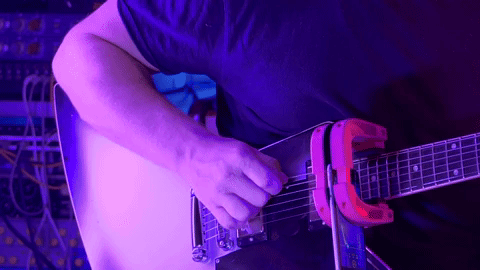Identifying Elbow Motion
The elbow is probably the simplest of all the motion mechanics. It’s just a hinge that moves in two directions, flexion and extension.
It’s powered by the muscles in the upper arm including the biceps for flexion, and the triceps for extension:

Elbow Form
Setting up for elbow motion usually involves one of two distinct forms that you can learn to recognize, even from a distance. Brendon Small uses the straight form, where the forearm rests on the guitar body, and the forearm and wrist point in the same direction:

Picking pioneer Steve Morse also has an elbow technique for which he uses the straight form. Both Steve’s form and Brendon’s form use a pronated forearm, where the thumb side of the forearm makes contact with the guitar body more so than the pinky side:

From this camera angle, you can see the slight shadow beneath Steve’s arm. That’s the pronated orientation causing a very slight air gap on the pinky side of the arm.
Nylon string maestro Bill Hall uses the radial offset form, where the wrist bends slightly in the direction of thumb, in the radial direction. This makes the forearm and wrist look a little like a hockey stick:

Hyperpicker John Taylor also uses the radial offset form:

Elbow Motion
The defining characterstic of elbow motion is that the forearm and the hand move together as a unit:

Thanks to the way you have to reach over the guitar’s body while the shoulder remains behind it, this causes elbow motion to move slightly away from the guitar body on downstrokes. But you’d be very unlikely to notice this from the typical audience perspective, especially if you didn’t know it was happening.
Instead, when you view elbow motion from Magnet perspective, you’ll spot the angled path of DSX motion right away, where upstrokes point between the strings and downstrokes point into the escape zone:

Pickslanting
The escape trajectory is shallow, about 10 or 15 degrees relative to the strings. Very often you will find that elbow pairs with a similarly shallow upward pickslant. Here’s John Taylor’s 15-degree upward pickslant:

If edge picking is used and the grip is adjusted to accomodate this, there may be no appearance of pickslant at all. So try not to worry too much about looking for the slant of the pick to identify elbow motion. Instead, observing the macro elements of the forearm and wrist moving together is the simplest way.
As for confirming the DSX motion path, closeup video works best for that. But familiarity with the phrase being played is also helpful. If every string change is a downstroke, that’s usually an indication that DSX motion is being used.
Other Motion Types
The elbow doesn’t have rotational capability like the shoulder joint, or multi-axis capability like the wrist, so it can’t change the way it moves to create other escape types. It is effectively a DSX-only motion mechanic. However, just because you see motion at the elbow joint doesn’t mean it’s the only joint that’s moving. Zakk Wylde and Tommy Emmanuel are both USX players who appear to use motion at the elbow joint, but we suspect that these are actually blends, with another joint such as the forearm or perhaps even the rotator cuff pitching in to create the upstroke escape.